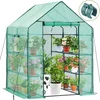Best Trees to Plant by State
Trees are vital to our ecosystem, offering numerous benefits such as shade, oxygen production, and habitat for wildlife. They come in various types, including deciduous, evergreen, fruit-bearing, and ornamental trees, each serving unique purposes in landscaping and the environment.
Search Plants by Zip Code
Deciduous trees, like oaks and maples, lose their leaves in the fall, providing a beautiful display of colors. Evergreen trees, such as pines and spruces, keep their foliage year-round, offering constant greenery. Fruit-bearing trees, including apple and cherry trees, provide both beauty and edible produce. Ornamental trees, like dogwoods and magnolias, are chosen for their stunning flowers and unique shapes.
Trees play a crucial role in combating climate change by absorbing carbon dioxide and releasing oxygen. They also help prevent soil erosion, provide shade, and create habitats for various species of birds and insects. In urban areas, trees can mitigate the heat island effect, making cities more livable.
When selecting trees for your garden, consider their mature size, growth rate, and maintenance needs. Some trees grow quickly and require regular pruning, while others grow slowly and need minimal care. It's essential to choose trees that are well-suited to your climate and soil conditions to ensure they thrive.
Proper planting techniques are vital for the health and longevity of trees. Ensure you have enough space for the tree to grow to its full size without interfering with buildings, power lines, or other structures. Dig a hole twice the width of the root ball and plant the tree at the correct depth.
Trees can serve various purposes in landscaping. They can act as focal points, provide privacy, create windbreaks, and add seasonal interest with their flowers, fruits, and foliage. By selecting a variety of trees with different characteristics, you can create a diverse and visually appealing garden.
In addition to their aesthetic and environmental benefits, trees can also have practical uses. For example, certain trees can be used for timber, firewood, or even medicinal purposes. Trees like willow and birch have been used for centuries in traditional medicine for their healing properties.
Long-term care is essential for the successful growth of trees. Regular watering, especially during the first few years, is crucial for establishing a strong root system. Mulching around the base of the tree can help retain moisture and suppress weeds. Pruning is also important to maintain the tree's shape and remove any dead or diseased branches.
Whether you're looking to add shade, beauty, or a habitat for wildlife, trees are a valuable addition to any landscape. With their wide range of sizes, shapes, and colors, there is a tree to suit every garden style and preference. Explore our selection of recommended tree plants below to find the perfect trees for your garden.
Trees are an essential part of any garden, providing structure, shade, and beauty. They can be used to create focal points, provide privacy, and add seasonal interest with their flowers, fruits, and foliage. By selecting a variety of trees with different characteristics, you can create a diverse and visually appealing garden.
When planting trees, it's important to consider their mature size and spacing requirements. Planting trees too close together can lead to overcrowding and poor air circulation, which can increase the risk of disease. Be sure to follow the recommended spacing guidelines for each type of tree to ensure they have enough room to grow and thrive.
Best Trees for Every State
Proper planting and care are essential for the successful growth of trees. Be sure to plant trees at the correct depth and water them regularly, especially during the first few years after planting. Mulching around the base of the trees can help to retain moisture and suppress weeds. Regular pruning is also important to maintain the shape and health of the trees.








